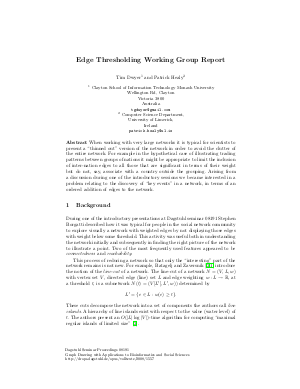08191 Working Group Report – Edge Thresholding
Authors Patrick Healy, Tim Dwyer
-
Part of:
Volume:
Dagstuhl Seminar Proceedings, Volume 8191
Part of: Series: Dagstuhl Seminar Proceedings (DagSemProc) - License:
 Creative Commons Attribution 4.0 International license
Creative Commons Attribution 4.0 International license
- Publication Date: 2008-07-22
File

PDF
DagSemProc.08191.3.pdf
- Filesize: 126 kB
- 4 pages
Document Identifiers
Subject Classification
Keywords
- Graph drawing
- edge thresholding
Metrics
- Access Statistics
-
Total Accesses (updated on a weekly basis)
0PDF Downloads0Metadata Views
Abstract
When working with very large networks it is typical for scientists to present a ``thinned out'' version of the network in order to avoid the clutter of the entire network. For example in the hypothetical case of illustrating trading patterns between groups of nations it might be appropriate to limit the inclusion of inter-nation edges to all those that are significant in terms of their weight but do not, say, associate with a country outside the grouping. Arising from a discussion during one of the introductory sessions we became interested in a problem relating to the discovery of ``key events'' in a network, in terms of an ordered addition of edges to the network.
Cite As Get BibTex
Patrick Healy and Tim Dwyer. 08191 Working Group Report – Edge Thresholding. In Graph Drawing with Applications to Bioinformatics and Social Sciences. Dagstuhl Seminar Proceedings, Volume 8191, pp. 1-3, Schloss Dagstuhl – Leibniz-Zentrum für Informatik (2008)
https://doi.org/10.4230/DagSemProc.08191.3
BibTex
@InProceedings{healy_et_al:DagSemProc.08191.3,
author = {Healy, Patrick and Dwyer, Tim},
title = {{08191 Working Group Report – Edge Thresholding}},
booktitle = {Graph Drawing with Applications to Bioinformatics and Social Sciences},
pages = {1--3},
series = {Dagstuhl Seminar Proceedings (DagSemProc)},
ISSN = {1862-4405},
year = {2008},
volume = {8191},
editor = {Stephen P. Borgatti and Stephen Kobourov and Oliver Kohlbacher and Petra Mutzel},
publisher = {Schloss Dagstuhl -- Leibniz-Zentrum f{\"u}r Informatik},
address = {Dagstuhl, Germany},
URL = {https://drops.dagstuhl.de/entities/document/10.4230/DagSemProc.08191.3},
URN = {urn:nbn:de:0030-drops-15570},
doi = {10.4230/DagSemProc.08191.3},
annote = {Keywords: Graph drawing, edge thresholding}
}
